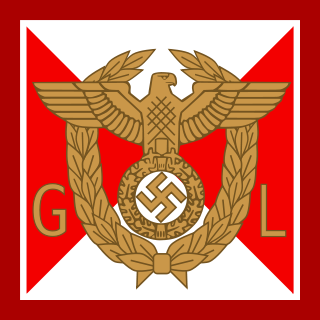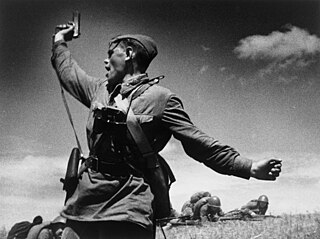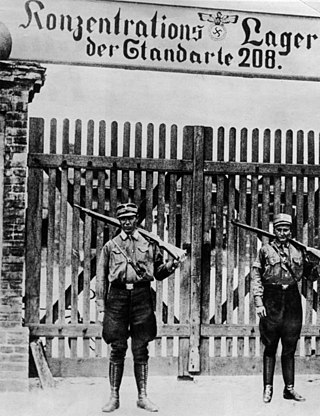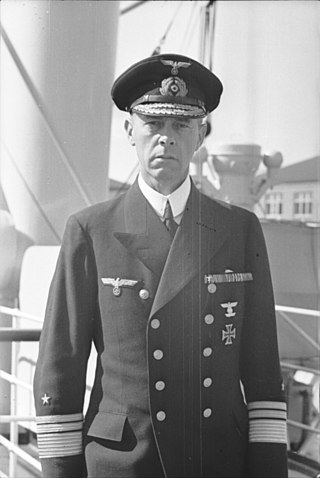
Betriebsobmann was a political position of the Nazi Party which existed between the years 1939 and 1945. The term first came into being at the start of World War II and was unique only to the local level of the Nazi Party, known as the Ortsgruppen.

Betriebsobmann was a political position of the Nazi Party which existed between the years 1939 and 1945. The term first came into being at the start of World War II and was unique only to the local level of the Nazi Party, known as the Ortsgruppen.
Translated as Shop Steward, or literally "Workers' Representative", the duties of the Betriebsobmann were generally the same as a labor union foreman and focused primary on the local level of war production as well as representing the interests of factory workers. Later, as the war progressed, the Betriebsobmann were in charge of production quotas and often would report workers who were not meeting standards. War defeatism and anti-Nazi sympathies were also immediately reported.
Betriebsobmann was divided into four levels of seniority, denoted by a letter placed after the title ranging from (A), (B), (C), and (D).
In addition to the primary rank of Betriebsobmann, a junior rank of Betriebsblockobmann existed as an assistant to the local Blockleiter . There was also a "Cell Operations Foreman" position, known as Betriebszellenobmann as well as a senior foreman position known as Hauptbetriebsobmann. In all, the following were the various levels of seniority:
The position of Betriebsobmann was not an actual political rank, but rather a title. Those Nazi Party members holding the position of Betriebsobmann also would hold one of several Nazi Party paramilitary ranks. The position of Betriebsobmann would be denoted by a political armband.

The Nazi Party, officially the National Socialist German Workers' Party, was a far-right political party in Germany active between 1920 and 1945 that created and supported the ideology of Nazism. Its precursor, the German Workers' Party, existed from 1919 to 1920. The Nazi Party emerged from the extremist German nationalist, racist and populist Freikorps paramilitary culture, which fought against communist uprisings in post–World War I Germany. The party was created to draw workers away from communism and into völkisch nationalism. Initially, Nazi political strategy focused on anti–big business, anti-bourgeois, and anti-capitalist rhetoric; it was later downplayed to gain the support of business leaders. By the 1930s, the party's main focus shifted to antisemitic and anti-Marxist themes. The party had little popular support until the Great Depression, when worsening living standards and widespread unemployment drove Germans into political extremism.

A Gauleiter was a regional leader of the Nazi Party (NSDAP) who served as the head of a Gau or Reichsgau. Gauleiter was the third-highest rank in the Nazi political leadership, subordinate only to Reichsleiter and to the Führer himself. The position was effectively abolished with the fall of the Nazi regime on 8 May 1945.

In the military, a political commissar or political officer is a supervisory officer responsible for the political education (ideology) and organization of the unit to which they are assigned, with the intention of ensuring political control of the military.

The uniforms and insignia of the Schutzstaffel (SS) served to distinguish its Nazi paramilitary ranks between 1925 and 1945 from the ranks of the Wehrmacht, the German state, and the Nazi Party.

The uniforms and insignia of the Sturmabteilung (SA) were Nazi Party paramilitary ranks and uniforms used by SA stormtroopers from 1921 until the fall of Nazi Germany in 1945. The titles and phrases used by the SA were the basis for paramilitary titles used by several other Nazi paramilitary groups, among them the Schutzstaffel (SS). Early SS ranks were identical to the SA, since the SS was originally considered a sub-organisation of the Sturmabteilung.

Blockleiter, where block refers to city block, was from 1933 the title of a lower Nazi Party political rank responsible for the political supervision of a neighborhood. Referred to in common parlance as Blockwart, the Block Warden's duty was to form the primary link between the Nazi authorities and the general population. The derogatory term Blockwart ("snoop") survives in German colloquial language.

Ranks and insignia were used by the National Socialist German Workers' Party (NSDAP) as paramilitary titles between approximately 1928 and the fall of Nazi Germany in 1945. Such ranks were held within the political leadership corps of the Nazi Party, charged with the overseeing of the regular Nazi Party members.
Helfer (transl. Helper) was a paramilitary rank of the Nazi Party between the years of 1938 and 1945. The Nazi rank of Helfer was a junior position of the Political Leadership Corps, ranking only above Anwärter. A Helfer in the Nazi Party typically served as a junior assistant to a higher official. The rank was created at first to replace the older Nazi rank of Blockleiter; however, a massive expansion of Nazi Party ranks in 1938 assigned the old duties of a Blockleiter to a rank known as Arbeitsleiter. The rank of Helfer then became an assistant position to such higher ranks.

Zellenleiter was a Nazi Party political title which existed between the years of 1930 and 1945. A Zellenleiter was higher in rank than a Blockleiter and was in charge of a "Nazi Cell", composed of eight to twelve city blocks.
Units and commands of the Schutzstaffel were organizational titles used by the SS to describe the many groups, forces, and formations that existed within the SS from its inception in 1923 to the eventual fall of Nazi Germany in 1945.

The Kriegsmarine was the navy of Nazi Germany prior to and during World War II. Kriegsmarine uniform design followed that of the preexisting Reichsmarine, itself based on that of the First World War Kaiserliche Marine. Kriegsmarine styles of uniform and insignia had many features in common with those of other European navies, all derived from the British Royal Navy of the 19th century, such as officers' frock coats, sleeve braid, and the "sailor suit" uniform for enlisted personnel and petty officers.

Abteilungsleiter, German for department head, was also a mid-level administrative political position of the Nazi Party, often held by staff political officers attached to various Gaue throughout Germany. The position of Abteilungsleiter was not an actual Nazi Party political rank, but a title held by a Party member in addition to their formal rank. The position was first created in 1933, after the Nazis had secured power in Germany.

Ortsgruppenleiter was a Nazi Party political rank and title which existed between 1930 and 1945. The term first came into being during the German elections of 1930, and was held by the head Nazi of a town or city, or in larger cities, of a neighbourhood, for the purposes of election district organization. After 1933, through the process of Gleichschaltung, the position of Ortsgruppenleiter evolved into the Nazi leader of a large town or city or of a city district.

Kreisleiter was a Nazi Party political rank and title which existed as a political rank between 1930 and 1945 and as a Nazi Party title from as early as 1928. The position of Kreisleiter was first formed to provide German election district coordination and, after the Nazi assumption of power, the position became one of county municipal government, effectively replacing the traditional German government establishment.

Dienstleiter was a high-ranking Nazi Party political rank of Nazi Germany which existed between 1933 and 1945. The rank was first created after the Nazi assumption of power and served as the second highest rank of the Reichsleitung Nazi Party organizational level, subordinate to the Reichsleiter.
Mitarbeiter was a Nazi Party political rank and title which existed between 1933 and 1945. As a political rank, Mitarbeiter was created in 1933 after the Nazis came to power in Germany. Considered the lowest political rank, Mitarbeiter replaced the older rank of Blockleiter and was also used as an administrative staff rank on the Kreis (County), Gau (Region), and Reich (National) Party Levels.

Gemeinschaftsleiter was a Nazi Party political rank which existed between 1939 and 1945. Created primary to replace the older rank of Stützpunktleiter, the rank of Gemeinschaftsleiter was often used on the local level of the Nazi Party to denote the second in command of a municipal region, answering to a regional Nazi known by the title of Ortsgruppenleiter.

Bereitschaftsleiter was a Nazi Party political rank which existed between 1939 and 1945. There were three levels of the rank, known as Bereitschaftsleiter, Oberbereitschaftsleiter, and Hauptbereitschaftsleiter.

Bereichsleiter was a Nazi Party political rank which existed between the years of 1939 and 1945. The rank of Bereichsleiter was created primarily to replace the older rank of Kreisleiter but was also used on higher levels of the Nazi Party as a senior Chief of Staff position.
Sonderbeauftragter was a Nazi Party political position which existed between the years of 1939 and 1945. The position of Sonderbeauftragter did not exist on the local level of the Nazi Party but was standard across County, Regional, and National Party lines.